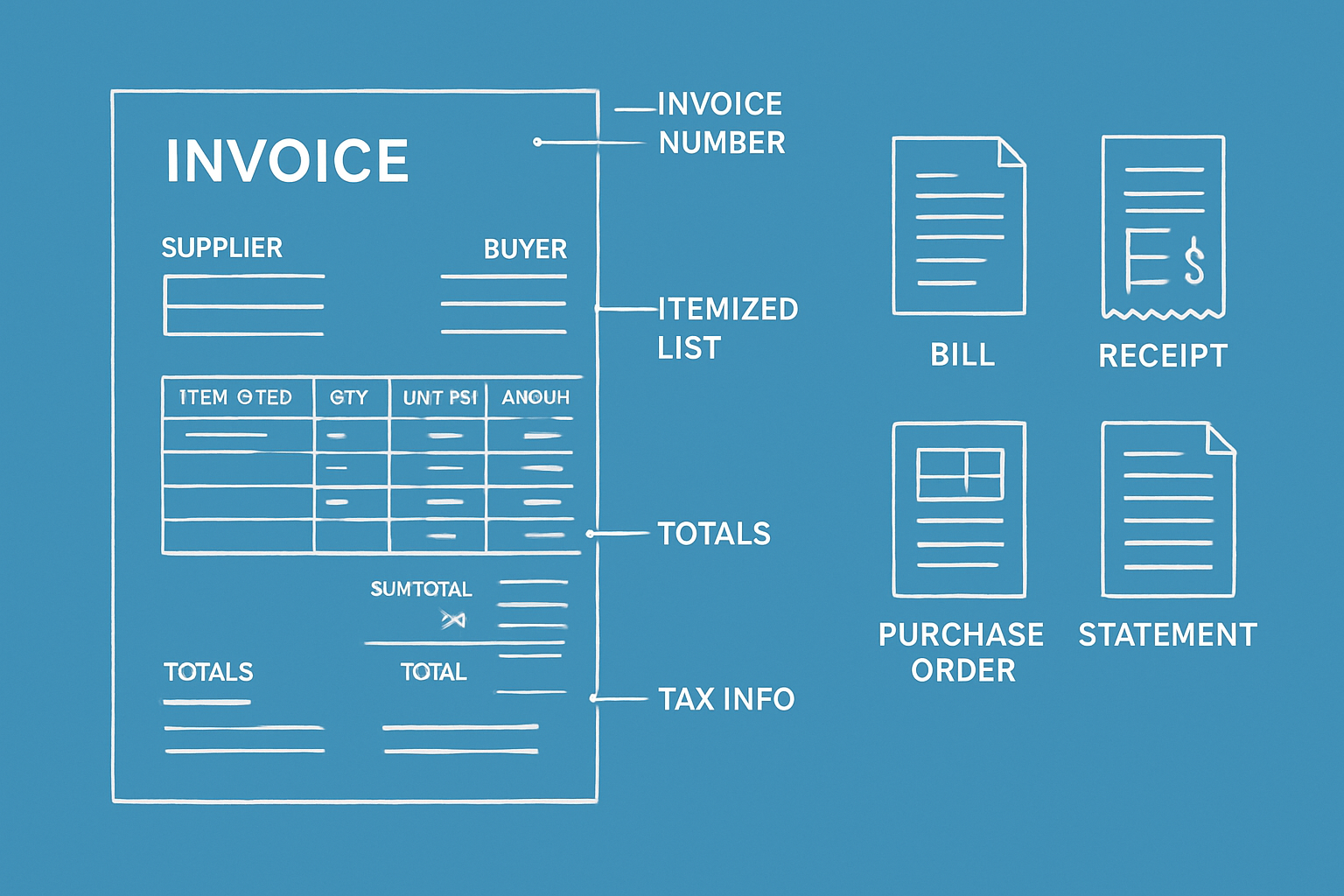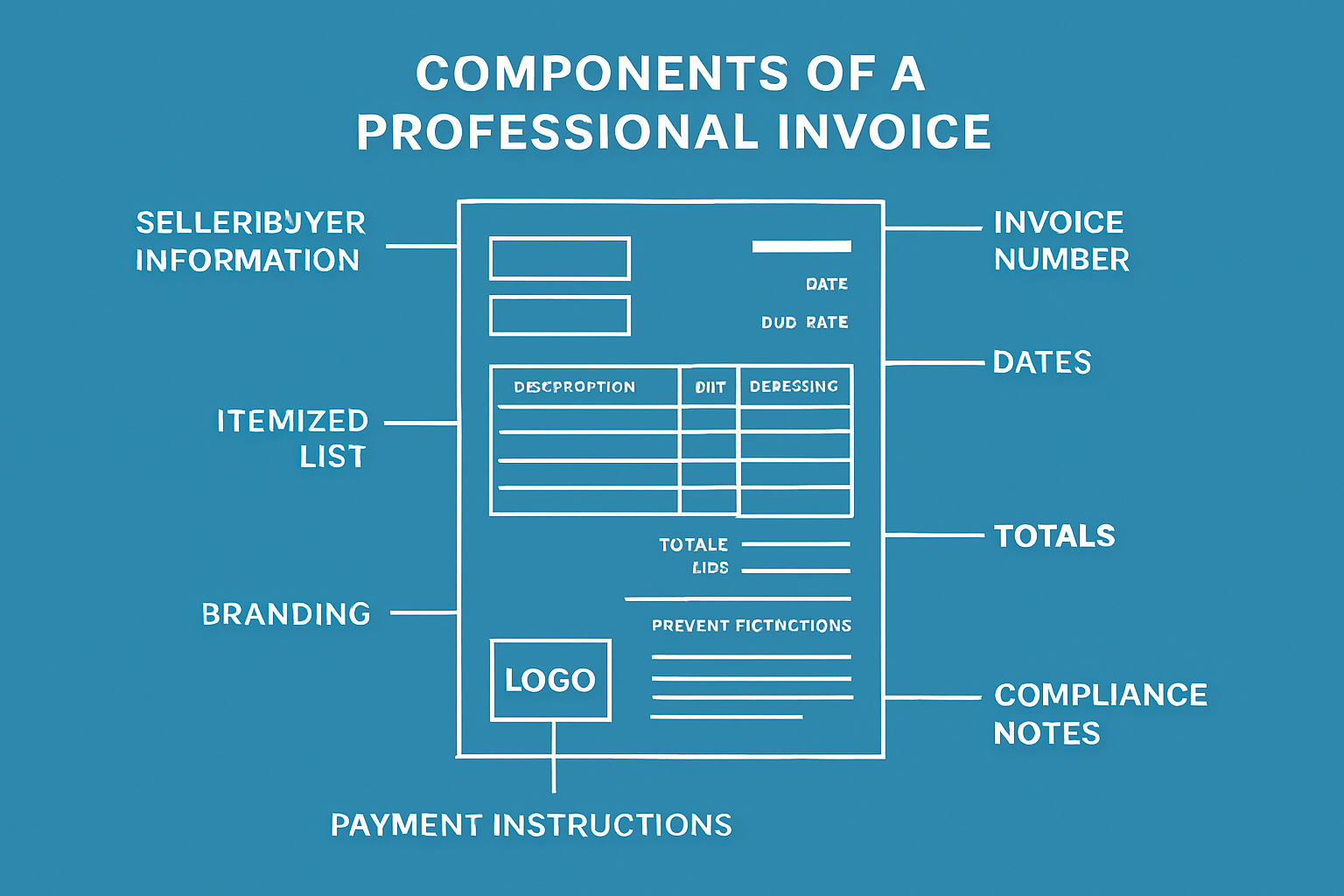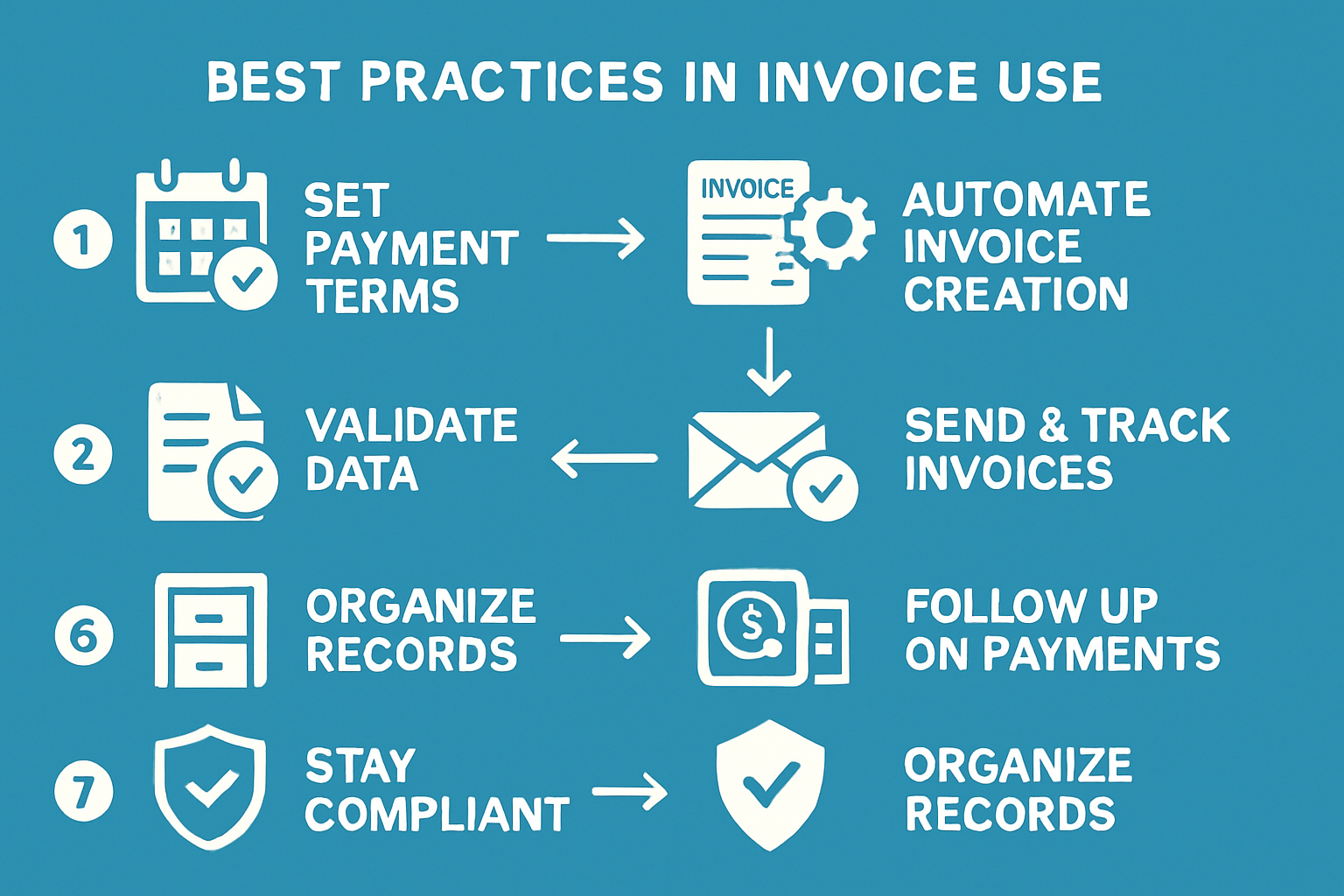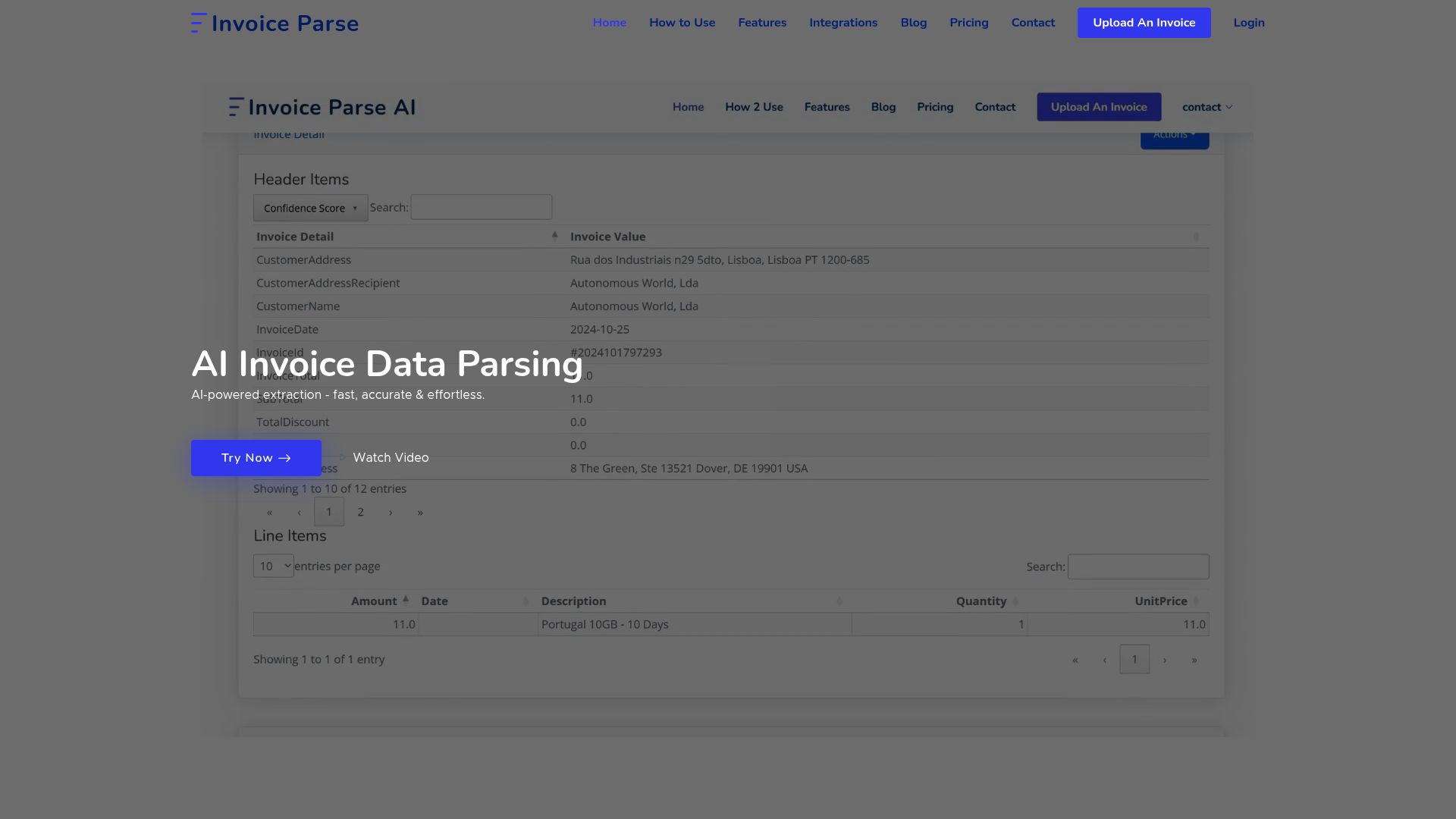Invoices keep businesses running, yet even the most experienced teams face hurdles with invoice use. As regulations shift and automation becomes essential, mastering invoice use is crucial for healthy cash flow, compliance, and professionalism. This guide will walk you through the fundamentals and new best practices for 2025. Discover what makes an invoice effective, learn to avoid common errors, and explore the latest technology to streamline your workflow. Ready to optimize your invoice use and stay ahead of industry changes? Let’s dive in and transform your invoicing process.

Invoice Use Guide: Best Practices and Tips for 2025
Understanding Invoices: Definition, Purpose, and Legal Requirements
Invoices are essential for every business transaction. Mastering invoice use is crucial for ensuring payments are requested and received correctly. But what exactly is an invoice, and how does it differ from other documents like bills or receipts? Let’s break it down.

What is an Invoice?
An invoice is a legally enforceable document that formally requests payment for goods or services provided. Unlike a bill, which is a more generic request for payment, an invoice is specific, detailed, and used for official business records.
| Document Type | Purpose | Legal Standing | Example Use |
|---|---|---|---|
| Invoice | Payment request, record | Yes | B2B service completion |
| Bill | Payment reminder | No | Restaurant meal |
| Receipt | Proof of payment | No | Retail purchase |
| Purchase Order | Authorization to buy | Yes | Office supplies order |
| Statement | Account summary | No | Monthly client summary |
Invoice use requires including what is being billed, who is involved, and when payment is due. For example, a B2B agency issues an invoice after completing a project, ensuring clarity and legal protection for both parties.
The Purpose of Invoices in Business
The main goal of invoice use is to formally request payment while establishing a clear agreement between seller and buyer. Invoices also create a reliable record for both parties, simplifying accounting and making it easier to track outstanding balances.
Good invoice use supports tax compliance and provides a solid audit trail. This helps with both day-to-day operations and future audits. In addition, professional invoices enhance transparency and trust. For instance, a detailed invoice helps track payment history and makes account reconciliation straightforward.
Legal and Regulatory Requirements for Invoices in 2025
Modern invoice use must comply with strict legal and regulatory standards. Every invoice should include a unique invoice number, supplier and customer details, description of goods or services, supply date, invoice date, amounts, and tax information (such as VAT number if relevant).
Digital and cross-border invoice use requires adapting to new mandates like the UK’s HMRC and EU e-invoicing directives. Failing to comply can result in tax penalties or delayed payments. For example, limited companies must state their registered company name, while sole traders need their trading name and address. For a step-by-step approach to ensuring compliance, consult this invoice audit checklist key steps guide.
Common Invoice Types and When to Use Them
There are several types of invoice use, each fitting different scenarios:
- Pro forma invoices for upfront payment estimates or international trade.
- Credit invoices to reflect refunds or corrections.
- Staged payment invoices for project milestones, common in construction.
- Recurring invoices for ongoing services like software subscriptions.
- Composite invoices for multiple deliveries or services combined.
Understanding when to apply each invoice type streamlines your workflow. For example, recurring invoice use is ideal for SaaS businesses, while staged invoices suit complex projects with multiple deliverables.
Key Components of a Professional Invoice
A professional invoice is more than just a request for payment. It’s a reflection of your business’s reliability, attention to detail, and commitment to smooth transactions. Mastering invoice use means understanding both required elements and the best ways to present them.

Essential Elements Every Invoice Must Include
For effective invoice use, include all legally required details. A complete invoice should have:
- Seller and buyer names, addresses, and contact details
- Unique invoice number and reference
- Invoice date and supply date
- Itemized descriptions of products or services, with quantities, unit prices, and totals
- Total amount due and clear payment instructions
Missing any of these can lead to disputes or delayed payments. For example, a detailed invoice with itemized charges helps clients verify every charge, minimizing confusion and speeding up payment. Always double-check these essentials before sending to ensure smooth invoice use.
Optional and Best-Practice Additions
Going beyond the basics of invoice use can make a significant difference in how quickly you get paid. Consider adding:
- Purchase order (PO) numbers for streamlined processing
- Contact person or purchasing manager’s name for clarity
- Tax rates, discounts, or surcharges
- Payment terms (such as Net 30 or early payment incentives)
- Late payment penalties and clear return policies
Including payment instructions and terms upfront helps reduce delays. For an in-depth look at optimizing these areas, check out these invoice processing best practices. Thoughtful invoice use with these additions signals professionalism and encourages timely payments.
Formatting and Branding for Professionalism
Consistent branding and clear formatting help your invoice stand out and build trust. For optimal invoice use, include your company logo, use brand colors and fonts, and ensure the layout is clean and easy to read.
Digital and PDF formats make invoices simple to share and archive. Make sure your invoices are accessible on both desktop and mobile devices for client convenience. A well-branded invoice not only supports your brand image but also reassures clients of your professionalism, leading to smoother invoice use and faster settlement.
Compliance and Localization Considerations
Proper invoice use also means adapting to local laws and industry standards. If you operate internationally, your invoices may need to comply with specific VAT/GST rules, language requirements, or digital signature mandates.
E-invoicing standards such as PEPPOL in the EU may apply to certain transactions, and data privacy rules require secure storage of client information. For example, EU businesses sending invoices to government bodies must use PEPPOL-compliant formats. Staying current with compliance ensures your invoice use is both legal and efficient, wherever you do business.
Best Practices for Creating, Sending, and Managing Invoices
Mastering invoice use means adopting smart, repeatable practices that keep your cash flow healthy and your business compliant. Let’s break down the steps you can follow to optimize every stage of your invoicing workflow.

Step 1: Establish Clear Payment Terms Upfront
Before you begin any project, set crystal-clear expectations about payment. Defining payment due dates, accepted methods, and late fees in writing helps avoid confusion later. Reference these terms in your contracts and on every invoice use instance.
For example, choosing Net 15 over Net 60 can have a dramatic impact on cash flow. Here’s a quick comparison:
| Term | Payment Due | Cash Flow Impact |
|---|---|---|
| Net 15 | 15 days | Faster cash inflow |
| Net 60 | 60 days | Slower cash inflow |
According to Payhawk, unclear or delayed payment terms are a leading cause of cash flow issues for SMEs. By making them explicit, you improve transparency and encourage timely payment.
Step 2: Use Automation and Invoice Management Tools
Modern invoice use is all about efficiency. Digital invoicing tools speed up processes, reduce manual errors, and integrate with accounting, CRM, or ERP systems. Features like batch invoicing and recurring billing are especially useful for subscriptions or retainers.
Automation can handle repetitive tasks, freeing up your team for higher-value work. For a deeper dive into streamlining invoice use with automation, check out Automating invoice workflow tasks.
For example, automating monthly retainer invoices ensures clients receive bills on time—no manual entry required.
Step 3: Ensure Accurate and Complete Data Entry
Accurate data is the backbone of reliable invoice use. Double-check client information, product details, and amounts before sending each invoice. Using checklists or automated validation features helps prevent costly mistakes.
Imagine sending an invoice with a wrong PO number or missing address. These errors can trigger payment delays or disputes. Many businesses now use built-in validation tools to catch issues before invoices go out, reducing headaches for both parties.
Step 4: Send Invoices Promptly and Track Delivery
Timely delivery is essential for effective invoice use. Send invoices as soon as work is completed or goods are delivered. Many platforms offer email tracking or customer portals, so you can confirm when an invoice is received and opened.
For example, service providers who invoice after project milestones often see faster payments. Prompt invoicing keeps your pipeline moving and reduces the risk of forgotten or delayed payments.
Step 5: Follow Up on Outstanding Payments
Following up is a vital part of invoice use. Set reminders for upcoming due dates and overdue invoices. Start with polite reminders, escalating communication if needed.
Automated reminders can reduce overdue invoices by up to 30%. For instance, scheduling weekly follow-ups helps keep your receivables in check and shows clients you’re proactive and organized.
Step 6: Maintain Organized Records for Audit and Analysis
Effective invoice use includes systematic record-keeping. Store invoices securely in digital or cloud-based systems. Tagging and categorizing invoices makes retrieval easy during audits or financial reviews.
Use analytics tools to identify late-paying clients, seasonal trends, or recurring issues. Organized records not only support compliance, but also give you valuable insights to improve your processes.
Step 7: Stay Updated on Compliance and Industry Trends
Regulations around invoice use are always evolving. Stay informed about changes in tax law, e-invoicing mandates, and payment technologies in your region.
Regularly review and update your invoice templates to reflect new requirements. Adapting to trends—like e-invoicing in the EU or emerging US standards—helps you avoid penalties and keeps your business competitive.
Overcoming Common Invoice Challenges in 2025
Cash flow hinges on effective invoice use, yet businesses are still grappling with persistent invoicing issues in 2025. Tackling these obstacles means understanding their root causes and adopting targeted strategies. Let's break down the most pressing challenges and how to overcome them.
Late Payments and Cash Flow Management
Late payments continue to threaten healthy cash flow for many companies. Poor invoice use often results in extended payment cycles, leaving businesses to chase overdue accounts.
To address this, set clear payment terms and communicate them upfront. Offer early payment incentives or apply late fees to encourage prompt settlements. Use automated reminders to nudge clients as deadlines approach.
- Early payment discounts
- Automated overdue notices
- Transparent payment terms
According to industry data, over 60% of businesses experience significant payment delays. For a deeper dive into these persistent pain points, check out Challenges in invoice processing.
Invoice Disputes and Error Prevention
Invoice disputes can stall payments and damage client relationships. Common triggers include incorrect amounts, missing details, or vague descriptions. Consistent invoice use with thorough data entry is your first line of defense.
Always double-check line items, quantities, and pricing before sending invoices. Include purchase order numbers and a contact person for quick resolution if questions arise. Proactive communication can defuse most issues before they escalate.
- Use checklists or validation tools
- Itemize all products/services
- Reference contracts and POs
A clear, accurate invoice use process minimizes disputes and keeps payments on track.
Manual Data Entry and Processing Bottlenecks
Manual invoice entry is time-consuming and error-prone. High volumes can overwhelm teams, causing delays and inaccuracies that disrupt invoice use workflows.
Switching to automation solutions reduces repetitive tasks and the risk of mistakes. Integrate your invoicing platform with accounting or ERP systems to streamline the entire process. Batch processing and digital approvals further accelerate turnaround.
- Automate invoice generation
- Integrate with finance software
- Use batch and recurring billing
By modernizing invoice use with technology, staff can focus on value-added work rather than manual entry.
Compliance Risks and Regulatory Complexity
Tax regulations and digital mandates are evolving rapidly. Non-compliant invoice use can trigger audits, fines, or payment holds. Staying current with rules—like VAT/GST rates, e-invoicing standards, and data privacy laws—is essential.
Customize invoice templates to meet local requirements. Implement digital signatures and secure archiving for audit-readiness. Regularly review compliance checklists and industry updates to reduce risk.
- Update templates for each region
- Securely store digital invoices
- Monitor regulatory changes
Effective invoice use means never leaving compliance to chance.
Scaling Invoice Management for Growing Businesses
Growth brings more invoices, greater complexity, and higher stakes for invoice use. Manual processes quickly become unsustainable as transaction volumes rise.
Adopt centralized invoice management platforms with workflow approvals and automation to handle scaling demands. These tools support multi-entity operations, permissions, and analytic insights.
| Challenge | Solution |
|---|---|
| High volume | Batch automation |
| Approval delays | Workflow management |
| Multi-entity needs | Centralized platforms |
| Data silos | Integrated systems |
Scaling invoice use efficiently ensures smooth operations as your business expands.
Leveraging Technology: Automation and AI for Smarter Invoicing
Embracing technology is vital for efficient invoice use in 2025. Automation and AI are changing the landscape, transforming how businesses create, process, and analyze invoices. These advances help companies streamline operations, reduce errors, and stay ahead of compliance demands.
The Role of Automation in Modern Invoicing
Automation has revolutionized invoice use by reducing manual work and increasing accuracy. Modern systems can generate invoices, send reminders, and even reconcile payments automatically. This means finance teams spend less time on repetitive tasks and more on analysis.
Integrating automation with finance and ERP systems ensures seamless data flow. For example, automated procure-to-pay solutions can streamline accounts payable, helping businesses avoid costly delays. Companies that automate invoice use processes often see improved cash flow, fewer errors, and greater compliance.
AI-Powered Invoice Data Extraction and Analysis
AI brings a new level of intelligence to invoice use. Advanced algorithms can parse invoices in various formats, extracting critical details like vendor names, amounts, and line items without relying on templates. This adaptability makes it easier to process large volumes of invoices in less time.
AI tools also support analytics, offering insights into spending patterns and vendor performance. According to the future of invoice processing with AI, businesses leveraging AI in invoice use can expect faster turnaround and reduced error rates, directly impacting efficiency and profitability.
AI Invoice Data Extraction with Invoice Parse
Invoice Parse is a leading example of how AI is reshaping invoice use. This platform uses advanced AI to extract data from PDF and image invoices—no templates required. It adapts to any invoice format, making integration easy for businesses of all sizes.

Users can export data to Excel, Power BI, and connect with tools like Zapier or Make. With a free tier for up to 5 daily parses, Invoice Parse enables small teams to automate invoice use, while scalable plans suit larger organizations. This streamlines workflows, reduces manual entry, and improves data-driven decision-making.
Choosing the Right Invoicing Software and Integrations
Selecting the best software for invoice use requires careful evaluation. Look for solutions that offer template customization, multi-currency support, compliance features, and robust reporting. Scalability and user-friendliness are essential as your business grows.
Integration capabilities are key for seamless invoice use. The right system should connect with your accounting, CRM, and analytics platforms. This enables real-time data sharing and ensures all aspects of invoice use remain efficient and accurate.
| Feature | Importance for Invoice Use | Example Benefit |
|---|---|---|
| Template Customization | High | Brand consistency |
| Compliance Tools | Critical | Avoids penalties |
| Multi-currency | Essential for global invoice use | Supports expansion |
| Integrations | High | Real-time workflows |
Future Trends: E-Invoicing, Blockchain, and Real-Time Payments
The future of invoice use is shaped by innovation. E-invoicing adoption is accelerating, with governments introducing new mandates for digital compliance. Blockchain technology is emerging as a tool for authenticating invoices and preventing fraud.
Real-time payments and digital wallets are making invoice settlement faster, benefiting both buyers and sellers. Networks like PEPPOL in the EU are setting new standards for secure, efficient invoice use. Staying updated on these trends will keep your business competitive and compliant.
Industry-Specific Invoice Use Cases and Tips
Every industry has its own unique approach to invoice use, shaped by workflow complexity, client expectations, and compliance needs. Understanding these nuances helps businesses tailor their invoicing processes for greater speed, accuracy, and professionalism.
Freelancers and Small Businesses
For freelancers and small businesses, invoice use centers on speed and simplicity. These professionals often juggle multiple clients, so quick turnaround and error-free billing are crucial. Leveraging invoice templates and mobile invoicing apps saves time and ensures consistency.
Best practices include:
- Use pre-built templates for fast invoice creation.
- Add payment links for instant online payment.
- Automate reminders for overdue invoices.
With streamlined invoice use, freelancers can project professionalism and get paid faster. For example, a graphic designer can send branded invoices from their phone moments after project sign-off, minimizing delays and boosting cash flow.
Mid-Market and Enterprise Organizations
As organizations grow, invoice use becomes more complex. Mid-market and enterprise teams must manage thousands of invoices across departments and entities. Automation is essential for handling approvals, routing, and compliance checks at scale.
Key strategies:
- Centralize invoice intake and approval workflows.
- Integrate invoicing with ERP and accounts payable systems.
- Monitor compliance with evolving regulations.
Staying ahead of accounts payable automation trends for 2025 helps enterprises reduce manual errors, improve visibility, and support growth. For instance, a multinational manufacturer can automate invoice routing and tax validation to ensure smooth operations across borders.
Subscription and SaaS Businesses
Recurring revenue models demand specialized invoice use. Subscription and SaaS companies rely on automated billing cycles, renewals, and proration to manage customer accounts efficiently. Clear communication is vital for handling failed payments or plan changes.
Tips for success:
- Automate recurring invoices for each billing period.
- Include detailed breakdowns of charges and proration.
- Set up dunning emails for failed payments.
With optimized invoice use, SaaS firms can scale without losing track of renewals or revenue. For example, a software provider automatically sends monthly invoices and alerts customers to update payment methods if a charge fails.
Project-Based and Construction Firms
Invoice use in project-based industries is tied directly to milestones and deliverables. Construction firms, for example, need staged payment invoices that reflect ongoing progress and detailed line items for materials and labor.
Best practices include:
- Create invoices for each project phase or milestone.
- Itemize costs for transparency.
- Track running totals and balances due.
This approach to invoice use ensures clients understand what they’re paying for and when. A builder might issue an invoice after completing foundation work, then follow up with new invoices as each phase finishes.
Global and Cross-Border Businesses
For businesses operating internationally, invoice use requires careful attention to compliance, currency, and localization. Multi-currency support and adherence to local tax regulations are non-negotiable.
Key considerations:
- Use invoice templates in multiple languages.
- Display amounts in both local and base currencies.
- Stay compliant with regional e-invoicing standards.
With thoughtful invoice use, exporters can avoid costly errors and payment delays. For instance, a global distributor adapts invoices for each market, ensuring tax information and language meet local requirements.
Now that you know how to create professional, compliant invoices and leverage the latest technology for smoother workflows, why not make your own invoicing process even easier? If you’re ready to save time, avoid manual errors, and get organized for 2025, try using an AI-powered tool to extract key invoice data in seconds—no templates or tedious data entry needed. You can even export everything to Excel or Power BI for deeper insights. Give it a go and see how much smoother invoicing can be with the Free Invoice Parser.
